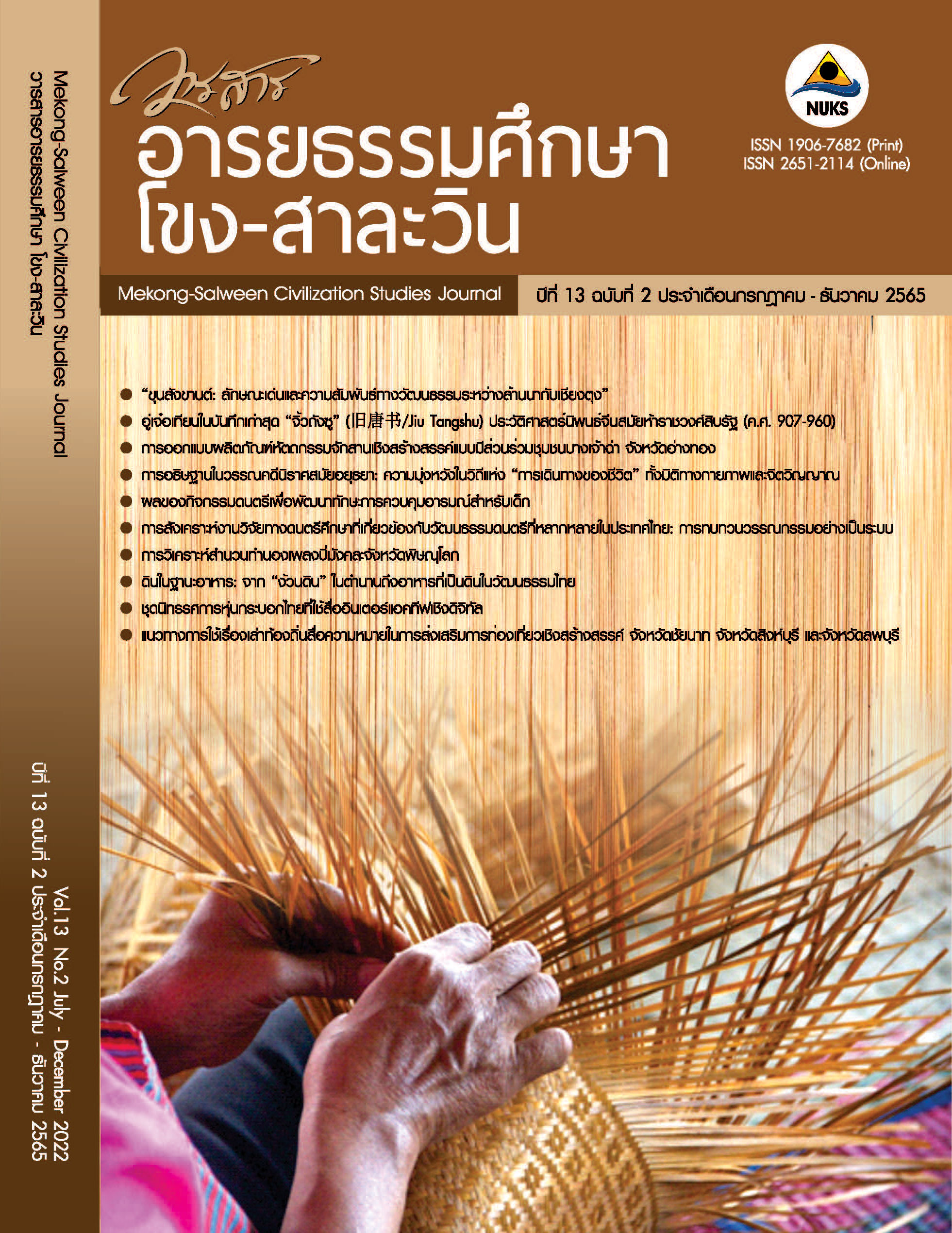ดินในฐานะอาหาร: จาก “ง้วนดิน” ในตำนานถึงอาหารที่เป็นดินในวัฒนธรรมไทย ดินในฐานะอาหาร: จาก “ง้วนดิน” ในตำนานถึงอาหารที่เป็นดินในวัฒนธรรมไทย
Main Article Content
บทคัดย่อ
ในมิติวัฒนธรรมครั้งสังคมบรรพกาลมนุษย์บางกลุ่มเชื่อว่าถือกำเนิดมาจากดิน นับถือผีดินเป็นเทพเจ้า และผีบรรพบุรุษ เมื่อจะทำอาหารก็นำดินมาทำแม่เตาไฟในครัวไฟ ครั้นจะทำพิธีกรรมสำคัญก็ต้องมีการ “ปลุกพระธรณี” หรือบอกกล่าวแก่ผีดิน เมื่อตายก็ฝังลงดินคืนสู่อ้อมอกของแผ่นดิน นอกจากนี้“ดิน” ยังนับเป็นอาหารชนิดแรกของมนุษย์ในตำนานทางพระพุทธศาสนา ดังปรากฏเรื่อง “ง้วนดิน” ซึ่งเป็นดินที่ถูกเผาไหม้จากไฟประลัยกัลป์ปรากฏในคัมภีร์อัคคัญญสูตรและคัมภีร์ในกลุ่มจักรวาลวิทยาในสังคมไทย ด้วยเหตุนี้จึงน่าสนใจว่าร่องรอยการกินดินของมนุษย์ยังคงหลงเหลือในวัฒนธรรมไทยอย่างไร บทความนี้จึงมีวัตถุประสงค์เพื่อศึกษาดินในฐานะอาหารทั้งจากตำนานและในวิถีชีวิต โดยศึกษาจากเอกสาร ตำรา และคัมภีร์ต่าง ๆ ผลการศึกษาพบว่าในสังคมไทยมีพิธีกรรมและความเชื่อเกี่ยวกับดินทั้งที่มาจากความเชื่อดั้งเดิมและความเชื่อใหม่คือ จากศาสนาพราหมณ์และพระพุทธศาสนา นอกจากนี้ยังพบนิทานและตำนานต่าง ๆ ที่กล่าวถึงอนุภาค “มนุษย์กินดิน” ส่วนในวิถีชีวิตจริงก็พบว่ามีการกินดินเช่นกัน โดยแบ่งดินที่กินเป็น 3 ประเภทคือ 1) ดินที่มีคุณลักษณะพิเศษ 2) ดินที่มีสรรพคุณพิเศษ และ 3) ดินที่มีอานุภาพพิเศษ การที่ปรากฏเรื่องราวมนุษย์กินดินในตำนานนับเป็นหลักฐานการกินดินมาแต่สังคมบรรพกาลในชีวิตจริงสะท้อนให้เห็น 1) ดินกับการเชื่อมโยงระหว่างมนุษย์กับธรรมชาติ 2) ดินกับการแสดงว่ามนุษย์เป็นหนึ่งเดียวกับธรรมชาติ และ 3) ดินกับการแสดงว่ามนุษย์เป็นส่วนหนึ่งของธรรมชาติ
Downloads
Article Details

This work is licensed under a Creative Commons Attribution-NonCommercial-NoDerivatives 4.0 International License.
References
Arunsak, K. (2017). Dhipayapratima: Origins and Meanings 14 Dhipaya of fortune-abundance of Thailand and Asia. Nonthaburi: Museum Press.
Baanjomyut. (2000). Theory of Buddhist world evolution. Retrieved January 18, 2022, from https://www.baanjomyut.com/library_3/
Baothong, S. (2010) Beliefs about eating soil. Retrieved January 28, 2022, from https://sites.google.com/site/tuysaranya/
Boonpitak, S., et al. (2016). Culture Traditional and Local Knowledge of Farmer's Plant Local Rice in Muang and Sai Ngam Districts, Kamphaeng Phet Province. [Special issue]. The Golden Teak : Humanity and Sai Ngam Districts, Kamphaeng Phet Province. [Special issue]. The Golden Teak : Humanity and Social Science Journal (GTHJ.), 22, 94-103.
Chao Phraya Phra Klang (Hon). (1946). Rajadhiraj episode 15, extracted from the Raman Chronicle on Rajadhiraj. Retrieved January 29, 2022, from https://vajirayana.org/
Chinworasiriwat, N. (2020). The secret that soldiers must do before they travel far from home is to put soil on their heads. Retrieved January 29, 2022, from http://www.liekr.com/
Department of Cultural Promotion. (2012). Intangible Cultural Heritage: Nang Phokhawadee. Retrieved 29 January 2022, from http://ich.culture.go.th/index.php/th/ich/folk-literature/
Dhammapadattha. (2008). Pandivaga Vanna 8. The story about 500 monks. Retrieved February 2, 2022 from https://th.wikisource.org/wiki/
Fine Arts Department (1939). Chronicle Conference Region 72 The Legend of Suwan Khom Kham. Mrs. Wicharanawat and Phraya Wisetsupawat. Printed as a souvenir at the funeral of Mrs. Siew Kanchanasapt, her mother, on May 25, 1939 at Wat Makutkasatriyaram. Bangkok.
Flynt, W. (2004). Dixie's forgotten people: The South's poor whites. Bloomington: Indiana University Press. Harvey, G. E. (1925). History of Burma: From the Earliest Times to 10 March 1824. London: Frank Cass & Co. Ltd.
Harvey, G. E. (1925). History of Burma: From the Earliest Times to 10 March 1824. London: Frank Cass & Co. Ltd.
Jaifai, P. (2017). Book Review Ecology and Religion: Ecological Spirituality in Cross-Cultural Perspective. Panidhana : Journal of Philosophy and Religion,13(1), 183-187.
Kasempholkoon, A. (2012). The Maintenance of Identity of the “Chong” Ethnic Group: A Case Study from Song Nai BanRitual in Ban Thung Kai Dak, Amphoe Mueang, Trat Province. Journal of Thai Studies, 8(1),87-124.
Learning Center for Earth Science and Astronomy (LESA). (2010). Earth science and astronomy learning materials. Retrieved January 29, 2022, from http://www.pw.ac.th/emedia/media/science/lesa/index.html
Liao Seng, M. (2009). Revisiting the past of Isan people. Retrieved January 25, 2022, from https://changthaidotcom.wordpress.com/
Mitpraphan, W. (2012). Common Characteristics and Relationship between Literature and Locality of the legend of Pathom Kapp / Pathom Mun; the edition of Xishuangbanna Lanna and Isan. Journal of Humanities and Social Sciences Bansomdejchaopraya Rajabhat University, 9(1), 45-58.
Office of Information Technology, Sukhothai Thammathirat Open University. (2019). Phi Ta Haek.. Retrieved January 28, 2022, from https://library.stou.ac.th/odi/online/exhibition
Office of the Royal Society (2012). Din Thanan. Retrieved January 28, 2022, from http://legacy.orst.go.th/?knowledges
Patcharaphisuth, C. P., & Tansit, S. S. (2017). Eat soil as a snack. Retrieved January 28, 2022, from https://www.tnews.co.th/social/384065
Phayre, A. P. (1873). The History of Pegu: Journal of Asiatic Society of Bengal. N. P.: Oxford University.
Phichiansunthorn, C., & Jeeruangs, W. (2013). Handbook of Thai Traditional Pharmacy, Volume 4, Mineral Medicine. Bangkok: Amarin
Phrommathep, N. (2012). The Legend of Lanna Ghosts: Phi Pong Dong Dam. Retrieved January 28, 2022, from https://www.gotoknow.org/posts/150330
Sarikabutr, T. (1973) Buddhist scriptures. Bangkok : Sillapabannakhan.
Savanayon, N. (2006). The Encyclopedia of Thai Traditions - Folk Tradition Section, Volume 1 . Bangkok: Fine Arts Department.
Wiriyaburana, U., et al. (1968). The Royal textbook of Brahmachat: the most complete. Bangkok: Sor Thamphakdi's printing house.
Young, S. L. (2011). Craving earth : understanding pica : the urge to eat clay, starch, ice, and chalk. New York: Columbia University Press.

